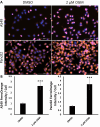Inhibition of GPR68 induces ferroptosis and radiosensitivity in diverse cancer cell types
- PMID: 39900965
- PMCID: PMC11791087
- DOI: 10.1038/s41598-025-88357-x
Inhibition of GPR68 induces ferroptosis and radiosensitivity in diverse cancer cell types
Abstract
Radioresistance is thought to be a major consequence of tumor milieu acidification resulting from the Warburg effect. Previously, using ogremorphin (OGM), a small molecule inhibitor of GPR68, an extracellular proton sensing receptor, we demonstrated that GPR68 is a key pro-survival pathway in glioblastoma cells. Here, we demonstrate that GPR68 inhibition also induces ferroptosis in lung cell carcinoma (A549) and pancreatic ductal adenocarcinoma (Panc02) cells. Moreover, OGM synergized with ionizing radiation to induce lipid peroxidation, a hallmark of ferroptosis, as well as reduce colony size in 2D and 3D cell culture. GPR68 inhibition is not acutely detrimental but increases intracellular free ferrous iron, which is known to trigger reactive oxygen species (ROS) generation. In summary, GPR68 inhibition induces lipid peroxidation in cancer cells and sensitizes them to ionizing radiation in part through the mobilization of intracellular free ferrous iron. Our results suggest that GPR68 is a key mediator of cancer cell radioresistance activated by acidic tumor microenvironment.
© 2025. The Author(s).
Conflict of interest statement
Declarations. Competing interests: LRN, JC, SR, CHW and CCH are inventors on a patent application related to this manuscript. DTF and CdAF declare no conflicts of interest.
Figures






References
-
- Lewanski, C. R. & Gullick, W. J. Radiotherapy and cellular signalling. Lancet Oncol.2, 366–370. 10.1016/S1470-2045(00)00391-0 (2001). - PubMed
-
- Hunter, A., Hendrikse, A., Renan, M. & Abratt, R. Does the tumor microenvironment influence radiation-induced apoptosis? Apoptosis. 11, 1727–1735. 10.1007/s10495-006-9789-1 (2006). - PubMed
-
- Röttinger, E. M. & Mendonca, M. Radioresistance secondary to low pH in human glial cells and Chinese hamster ovary cells. Int. J. Radiat. Oncol. Biol. Phys.8, 1309–1314. 10.1016/0360-3016(82)90580-6 (1982). - PubMed
MeSH terms
Substances
Grants and funding
LinkOut - more resources
Full Text Sources

